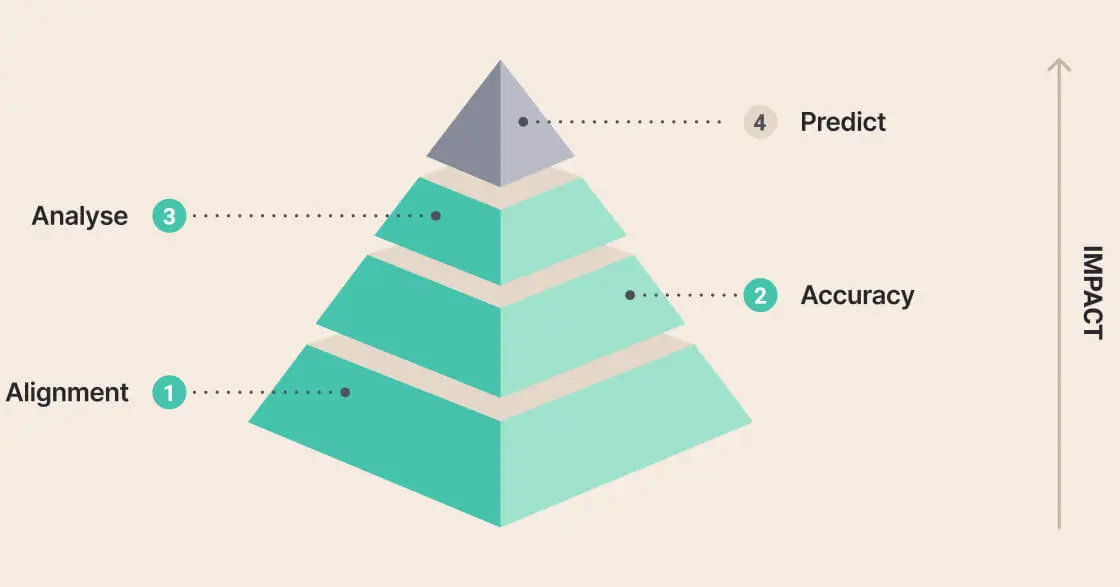What does it mean to be data-driven?

"Data-driven" is a buzzword for businesses investing in data, but gathering data indiscriminately is not enough.
Data is the foundation of every business, it is the basis for all decisions. But while it’s safe to say that data drives businesses, this isn’t the same as being ‘data-driven’. So, what does it mean to be data-driven?
Key Takeaways
- Businesses need a strategy combining alignment, accuracy, and analysis
- Bad data and data overload can impact decision-making accuracy
- A solid data strategy aligned with objectives and performance indicators is necessary
These days, the term ‘data-driven’ has become something of a cliched buzzword. The ‘data-driven’ hype has businesses investing more and more in data collection, storage, and analysis across platforms - but to what end?
Simply gathering data indiscriminately isn’t enough. It’s the insights and information derived from the data that are invaluable. Data is good - but it has to have a purpose.
For a business to be truly data-driven, it needs to have a solid data strategy in place that is aligned with business objectives and KPIs. The business needs to be collecting the right data through targeted governance and using it to deliver actionable insights through well-communicated analysis.
Without clear direction, the concept of being ‘data-driven’ falls apart.
The dangers of data overload
Like its not-so-distant cousins ‘AI’, ‘deep learning’ and ‘Big Data’, the buzz around ‘data-driven strategy’ has seen businesses of all shapes and sizes invest countless time and effort in attempts to harness (what seems like) unlimited amounts of data in the hopes of lassoing their next ‘unicorn’ insight.
Unsurprisingly, there aren’t a lot of unicorns out there. Despite their hard work, more businesses fail to generate value from their data-driven efforts.
That’s not to say they haven’t collected data. In fact, the opposite is true: there’s too much of it. And worse? It's messy and inaccurate. Instead of finding unicorns, businesses are catching big, bad, grizzly data bears and in turn, are becoming paralysed by the sheer volume of data in their nets.
Analysis paralysis is not only very real, it’s borderline epidemic
In a 2017 study of business decision-makers and employees across 14 countries, it was discovered that 62% of CEOs, 44% of IT workers, 63% of operations staff, and 70% of finance professionals agreed that information overload impacts them on a daily basis.[1]
So much focus is put on the act of gathering data, without any thought given to the fact that bad data poses a significant risk to the accuracy of decision-making at all levels of business.
Bad data has big consequences. It impairs the accuracy of your reporting so much so, that it can manipulate perceived performance, and can even imply you’re not hitting important KPI’s (where you may well be) or vice versa. This can have very real impacts on your business decision making, causing your team to analyse inaccurate trends or focus efforts on the wrong issues.
Getting the wrong data is the same as filling your car with diesel instead of petrol: it’s harmful to the running and can cause things to break down altogether.
Curing the bad data epidemic
Bad data doesn’t just appear. Data-driven activities are least effective when:
-
Commitment to the strategy isn’t shared across business levels.
-
There’s no business-wide vision to guide the strategy.
-
Transparency of data isn’t shared across all business levels.
-
The insights can’t be quickly actioned.
-
The data’s relevance and accuracy easily change over time or by stakeholders.
The root cause of these data woes comes down to a lack of truly data-driven strategy. So fighting back against this epidemic requires businesses to create a strategy that combines three core elements: Alignment, Accuracy, and Analysis.
Alignment
As with any good strategy, you need to begin by setting objectives, KPIs, and metrics that indicate success. Data strategy is no different.
Businesses must determine the data they actually need before they go out and grasp for any old straws that come along. It’s essential this is a collaborative process, because if decision-makers aren’t on board with the objectives, or if you’ve missed a business unit or department, then you aren’t going to be gathering data that is useful to the whole business. Something will always be missing.
Accuracy
By setting proper data governance processes and practices, businesses and their partners can improve the reliability of their data. Assigning roles and responsibilities in the tracking and storing of data is essential here. By setting specific targets for the type of data being gathered, businesses can ensure they get the right information.
Analysis
At Equilibrium, we use an approach called Data Journalism. This is dedicated to the objective of moving past the ‘what’ of data, and into understanding the ‘why’. By looking at both quantitative and qualitative customer data, you get the complete story. This then informs how the customer experience is optimised and enhanced.
Data Visualisation is an essential part of this process. Clean and well-visualised information allows you to communicate the value of data across an entire organisation, which is the key to unlocking its power. If everyone can understand your data, then all decisions can easily be aligned to this one clear truth.
The way forward
By creating a well-aligned data-driven strategy, businesses will capture only the data that’s relevant to their objectives and goals. This good governance ensures the collected data is accurate, preventing analysis paralysis by filtering out irrelevant information. In turn, businesses can be more efficient with their time, by only analysing the data that’s necessary, allowing for better, more accurate analysis.
Investigating the reasons why the trends identified through analysis are occurring enables businesses to deliver truly actionable insights. By looking at the causes of these trends, you’re able to paint a more rounded, fuller picture of the data’s story, allowing you to derive more meaningful insights and make more informed decisions.
Don’t just gather your data and hide it away in silos: make the results available to everyone, and present the data in engaging ways so that anyone in the business can access the insights identified, and understand their value. By providing ease of access to data and insights across all business levels, the efficiency and accuracy of decision-making will improve.
A truly data-driven strategy requires alignment with business objectives and KPIs, accuracy through governance, and well-communicated analysis. So in order to avoid the hype, businesses need to understand what it really means to be data-driven.
[1] The research for the Global Growth Index was conducted by Morar Consulting on behalf of Epicor in December 2017. The research questioned 2 450 business decision-makers and employees in businesses in 14 countries across the globe, about their growth performance in the last 12 months.




